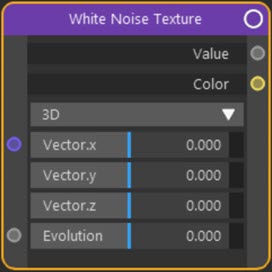Texture: White Noise
Node Interface

Overview
| Function | Generates a random number from an input position or value |
| Nearest C4D equivalent | Noise shader |
This node generates a random number using a position vector and/or a numeric value as the seed.
Settings
Note: a * symbol next to the name indicates the parameter also has an input port. A # symbol indicates that the parameter can only be changed with an input node, not in the node itself.
Dimensions drop-down menu
The noise is evaluated at a point in space depending on this menu. The options are:
1D
The texture is evaluated at a single point giving a uniform result. However, this can be changed over time by animating the 'Evolution' value.
2D
The texture is evaluated at a point in 2D space; the Z component of 'Vector' is ignored and 'Evolution' is not used.
3D
The texture is evaluated at a point in 3D space; 'Evolution' is not used.
4D
The texture is evaluated at a point in 3D space and 'Evolution' is used. That value can be animated to give an animated texture.
Vector *
The position at which the noise is evaluated. Not used if the 'Dimensions' menu is set to '1D'.
Evolution *
Changing this value will affect the final output if the 'Dimensions' menu is set to 1D or 4D. It can be animated to produce an animated texture.
This setting in Blender is called 'W'. We have chosen 'Evolution' as a more explanatory and industry-standard name.
Output
Value
The generated random value.
Color
 In addition to the random value output, this node can output a random colour. To try this out, connect the 'Value' port of an input Value node to the 'Vector' input of this node and change the value in the Value node to change the colour - only very small changes are required to give a very different colour.
In addition to the random value output, this node can output a random colour. To try this out, connect the 'Value' port of an input Value node to the 'Vector' input of this node and change the value in the Value node to change the colour - only very small changes are required to give a very different colour.